E. O. Adeyemo
Department of Educational Foundations and Counselling Faculty of Education Obafemi Awolowo University, Ile – Ife, Nigeria
Correspondence to: E. O. Adeyemo, Department of Educational Foundations and Counselling Faculty of Education Obafemi Awolowo University, Ile – Ife, Nigeria.
| Email: |  |
Copyright © 2015 Scientific & Academic Publishing. All Rights Reserved.
Abstract
This study examined lecturers perception on students competency in evaluating lecturers teaching effectiveness. It also determined the influence of professional status, age, sex and year of experience on lecturers’ perception of students’ competency in evaluating lecturers teaching effectiveness and examined lecturers perception on the formative and summative functions of students evaluation reports with a view to enhance effectiveness of teaching and learning in the Universities. The study adopted a descriptive research design. The population consisted of all academic staff of Obafemi Awolowo University, Ile – Ife. The sample size was 123 lecturers drawn across seven Faculties of the University. An adapted version of the instrument titled Lecturers Response to Students Evaluation of Teaching (LRSET) developed by Severino and Newman (2011) with reliability coefficient of 0.917 was used for this study. Lecturers response to this questionnaire were collected and the data were analysed using appropriate statistical analysis. The results revealed that 82.9 % of lecturers had a very positive perception, 11.4 % had fairly positive while 5.7% had negative perception. Sex do not influence the perception of lecturers about students competency in evaluating lecturers teaching effectiveness (Mean difference of male = (78.8 12.9) and Mean difference of female was 75.5 14.0 (t = 1.271, p 0.05.) There was no significant difference in the perception of students across sex (χ2 = 2.639, across age χ2 = 2.871, across professional status and across year of work experience χ2 = 4.931, p > 0.05). The results of the formative and summative functions of students evaluation revealed that 83 % perceived that the evaluation will help to improve teaching effectiveness, 75.5 % perceived that it will improve classroom instruction while 65.9% perceived that it could foster professional growth of lecturers. Lecturers had a very poor perception on the fact that the results of the evaluation should be used for promotion and salary increase (32.2 and 25.2% respectively) The study concluded that students evaluating lecturers teaching effectiveness was not an issue but that the results should not be used for promotion and payment of salaries of lecturers.
Keywords:
Perception, Teaching effectiveness, Formative, Summative, Evaluation
Cite this paper: E. O. Adeyemo, Lecturers’ Perception towards Students Assessment of Their Teaching Effectiveness in a Nigerian University, International Journal of Psychology and Behavioral Sciences, Vol. 5 No. 5, 2015, pp. 184-192. doi: 10.5923/j.ijpbs.20150505.02.
1. Introduction
Effective teaching is the extent to which a teacher is able to encourage students’ understanding of the subject matter.. Several research findings among [1] have been able to demonstrate the fact that effective teaching leads to good performance in courses and the key to improving performance in public examination is to place a highly skilled and effective teachers in our classrooms. The issue of teaching effectiveness of lecturers has always been a point of attraction since teaching effectiveness hinges on effective learning. A system that is committed to a high value effectiveness needed to be subjected to continuous assessment in order to sustain its standard, lecturers evaluation therefore is a vital part of educational process. Alongside, in as much as important decisions are made based on information obtained or received from any evaluation process, it is therefore necessary that any instruments used in the evaluation should be appropriate and valid.It is becoming a common practice in almost all higher institutions to conduct evaluation report on lecturers in other to gather feedback about lecturers’ teaching effectiveness. Many universities in Nigeria have devised various means of improving the performance of their students with a view of improving their productivity and performance in the world of work after graduation. Some of the approaches used are students’ evaluation, classroom evaluation, students rating, students’ achievement, peer rating, self rating, teachers’ interview, parents’ rating, competency test and indirect measuring. [2] identified nine approaches to educational evaluation, among these were classroom observation, students rating, teachers’ interview, parents rating, competence test and indirect measurement). [3] after an online study of 1883 students from ten university in Europe concluded that of all the techniques of evaluating lectures effectiveness, students’ evaluation proved to be more effective as providing specific information for formative and summative purposes and this should be an important part of teacher evaluation.[4] asserted that the question of whether or not lecturers should be evaluated is not the issue; rather, a key problem with the practice are largely who should do the evaluation and for what purpose and by what means should it be done. The opinion of some researchers was that the students who is being directly involved in teaching and learning processes from the teachers are in the position to evaluate their teaching because they observe the teachers directly in the class and also with the feelings that their findings could help to improve lecturers teaching performance. [5] found that students are generally willing to do the evaluation and provide feedback without any particular fear or feeling of repercussions. [6] also suggested that students are in unique position to evaluate their own increased knowledge and comprehension since it will be easy for students to know when schemes are covered and when test items covered the course contents. These notwithstanding, most people however believed that students rating may not be objective enough.The key problems associated with measurement and assessment of teaching effectiveness as highlighted by [7] also by [8] was that current measures for assessing academic for promotion in most Nigerian universities were not often linked with the capacity to teaching effectiveness. They pointed out that the existing Federal University Policies for measuring teachers or lecturers effectively either rely almost exclusively on perceptions of the head of department or focus on the lecturers’ course taking record or basic academic skills and subject matter knowledge. Aside qualification, paper publications, community service and commitment both at national and international levels were also considered as criteria for assessing promotion. These according to [8] were good but that they were not good predictors of teaching effectiveness.Some early studies tended to support the reliability of students’ evaluation of lecturers while some studies reported several pitfalls and cast doubts on the validity of the students rating. Most students may prefer lecturers who do not challenge them enough in terms of the materials, activities and tasks demand on course taking. Some of the students are not ready to put in their best in their studies and therefore see lecturers who demand for the best as wicked. There is the tendency therefore for students to rate low lecturers who will not compromise standard especially if they do not perform well in the course. [9] also discovered that students evaluation of lecturers’ performance were questionable in terms of its validity and reliability. The outcome of the evaluation was reported bias as the students assessed the teaching performance based on non-related learning measures and that in some cases, the ratings were influenced by lecturers’ personal behavior, gesture, mannerism, relationship, knowledge and skills. Teaching effectiveness on its own is multifaceted and any students’ rating which focuses on a single overall score of lecturers may be inadequate. A lecturer that is well organized and approachable with good interpersonal relationship may not be a good communicator. Failure to separate all these components could result to conflicting results in research findings but these notwithstanding, students opinion about a lecturer is of a particular importance because it represents an addition to the data constantly used to judge the competence of a lecturer. In view of this fact, the most popular and frequently used approach is students’ evaluation, however, the opinion and perception of lecturers about students’ evaluation has been a thing of debate.[10] carried out a survey involving 2000 lecturers from five public universities in Nigeria to investigate how lecturers perceived the importance of students’ evaluation. The general conclusion was that lecturers do not accept students’ evaluation, especially when it is used for promotion or salary increment purposes. They also viewed students’ evaluation of lecturers appropriate and necessary but their observation was that the lecturers receiving the best evaluation were not always the most effective. This therefore reveals that students’ are not adequate or competent enough to assess lecturers’ teaching effectiveness and same time the aforementioned renders their response invalid. Some researchers also received contradicting comments from some lecturers. Some of these comments were that if lecturers are good but strict, or the subjects taught are difficult, the students would give a wrong and bad evaluation. Other contradictory comments were that students evaluation were based on emotion since strict lecturers were evaluated badly compared with lazy but friendly ones. They also discovered that grades of students in a particular course could influence their evaluation of the course. All these could affect the validity and reliability of the evaluation results.On the contrary, [11] discovered some benefits in students evaluation. Among these were the fact that it increases the chances of recognizing and rewarding excellence in teaching, it provides means of interaction between the lecturers and the students taught, it provides direct and extensive information about the lecturers and also provides tangible evidences of students’ recognition i.e. students’ evaluation could be used to improve classroom instruction, students’ learning and also foster professional growth of the lecturers. [12] also opined that the results could be useful for administration and personnel decision like promotion, salary increase, demotion, dismissal and award. Several empirical studies on students’ evaluation of lecturers teaching effectiveness revealed gender difference. Some studies reported that students generally awarded lower rating for female educators than their male counterparts. According to [13] and [14] they found out that students perceived that female lecturers are biased, having an agenda, rigid grumpy and angry while the male were seen as objective, relaxed, comfortable, flexible ,open-minded, good humor and fair. Irrespective of all these short comings, students evaluation if conducted in a right way will be of benefits to many, both the stakeholders and to the university itself. It will also provide the opportunity to understand lecturers’ feeling and opinion as regards the students evaluating their teaching effectiveness. This information will bring improvement to teaching and learning processes in our universities.Obafemi Awolowo University, Ile –Ife, is one of the university presently practicing students on-line evaluation of lecturers teaching assessment, being one of the leading universities, there is the need therefore to find out the perception of lecturers towards students assessment of their teaching effectiveness. The question on ground is not whether lecturers should be evaluated but the issue at stake is rather to determine the authenticity of students rating and also to explore whether students are competent enough to rate their lecturers. There is also the need for the opinion and perceptions of lecturers on both the formative and summative purposes of the evaluation results. This is because evaluation results itself will be an effective tool for lecturers development if they themselves understand the value and agree with the processes involved. This study would yield potential benefits to many including the lecturers, the students and the university administrators, hence the need for this study.
1.1. The Objectives of the Study
The objectives of the study therefore are to:-i. examine lecturers perception on students competency in evaluating lecturers teaching effectivenessii. determine the influence of professional status, age, sex and year of experience on lecturers perception of students competency in evaluating lecturers teaching effectivenessiii. examine lecturers perception on the formative and summative functions of students evaluation report
2. Method
The study adopted descriptive research design. It sought to elicit information about the perception of university lecturers towards students evaluation of their teaching effectiveness.
2.1. Participants
The population consisted of all the lecturers of Obafemi Awolowo University, Ile-Ife. A sample size of 123 lecturers was drawn randomly across seven faculties of the university The Faculties used and their respective demographic profile were as presented in table 1.Table 1. Demographic Profile of the Respondents
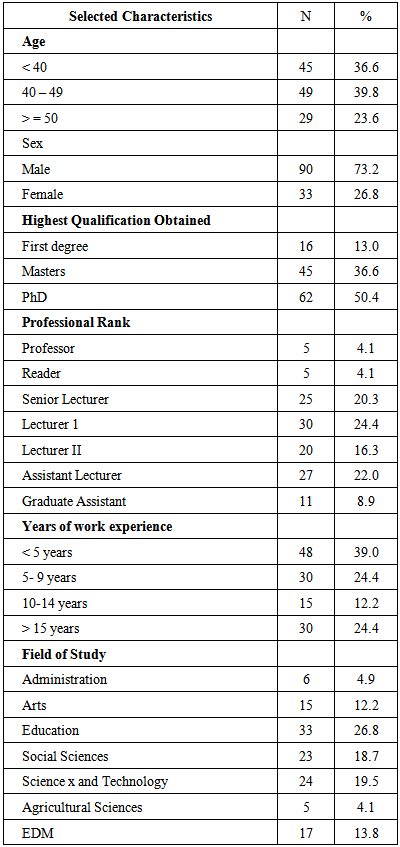 |
| |
|
2.2. Instrument
An adapted version of the instrument “Lecturers Response to Students Evaluation of Teaching (LRSET) developed by [15] and with Cronbach Alpha reliability Coefficient of 0.917 was used to generate data for the study. The instrument consisted of 20 items and structured on a five point Likert scale, graded strongly agree, agree, undecided, disagree, and strongly disagree was used to generate the data. Items 1-10 elicited information on the general need for evaluation, 11-15 were on the formative purposes, while 16-20 covered the summative aspect.
2.3. Procedure
The questionnaire were distributed to the lecturers and were required to indicate their personal opinion towards students evaluating their teaching effectiveness. Their responses were subjected to appropriate statistical analysis.
3. Results
Objective oneTable 1 illustrated the demographic characteristics of the respondent. Out of 123 lecturers, 45 were below the age of 40 while 49 were between the ages of 40-49 and 29 were above 50 years. Among the lecturers, 90 were male while 33 were female. Among the respondent, 62 were holder of PhD, while 45 had Masters and 16 possessed First Degree. Those with first degree were not lecturers but graduate assistant employed as tutorial lecturers, but in as much as this category relate with students in the teaching and learning process, there was the need to assess their perception too. Among the respondents were 5 professors, 5 readers, 25 senior lecturers, 30 lecture one, 20 lecturer two and 27 were either assistant lecturer or graduate assistant. As part of the investigation, 48 of the respondents had less than five years working experience, 30 had between 5 - 9years, 125 had between 10 - 14 years while 30 had more than 15 years of experience. These lecturers were selected from seven different faculties in the University (Administration, Arts, Education, Social Sciences, Science, Technology, Agriculture Environmental Design,). It was not possible to get a uniform number from each of the Faculty because of none uniformity in the number of lecturers across Faculties. The number of professors were fewer because of difficulty of accessibility to some of them.There were ten items on lecturers perception about students evaluation of lecturers effectiveness From the results, none of the ten items had an excellent perception. but generally the idea of students evaluation was highly acceptable with the highest response of 91.1%, 4.5  0.84. All items under the lecturers perception had a percentage above 50 which is an indication that lecturers had a positive perception towards students evaluation of their teaching effectiveness. This notwithstanding, the fact that majority supported the idea, there were reservations in some areas. The item that indicated that the evaluation will help lecturers to be .more disciplined had the lowest positive perception (62.6). This indicated that the lecturers had their reservations on the fact that affected whether they are disciplined or not or the way they choose to live their life. The results also revealed that the students were responsible enough to evaluate their lecturers (74.8%). There was the conscientious opinion that lecturers would be more prepared for their teaching if evaluated (81.3), and commitment to their job (79.7%). There was also a positive perception of the fact that the evaluation will make innovative in their teaching (78.9%).The bar chart in Figure 1 is a graphical representation of the information presented in Table 1.
0.84. All items under the lecturers perception had a percentage above 50 which is an indication that lecturers had a positive perception towards students evaluation of their teaching effectiveness. This notwithstanding, the fact that majority supported the idea, there were reservations in some areas. The item that indicated that the evaluation will help lecturers to be .more disciplined had the lowest positive perception (62.6). This indicated that the lecturers had their reservations on the fact that affected whether they are disciplined or not or the way they choose to live their life. The results also revealed that the students were responsible enough to evaluate their lecturers (74.8%). There was the conscientious opinion that lecturers would be more prepared for their teaching if evaluated (81.3), and commitment to their job (79.7%). There was also a positive perception of the fact that the evaluation will make innovative in their teaching (78.9%).The bar chart in Figure 1 is a graphical representation of the information presented in Table 1.Table 1. Examining Lecturers Perception on students competency in evaluating lecturers teaching effectiveness
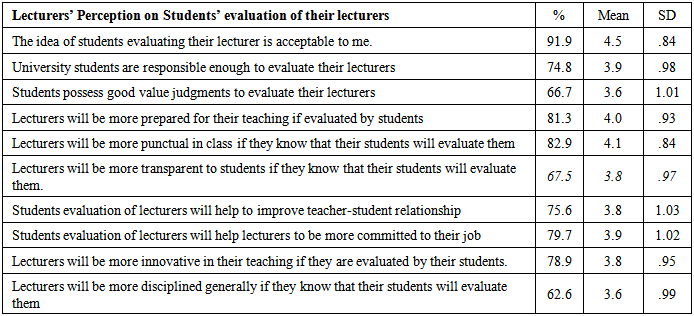 |
| |
|
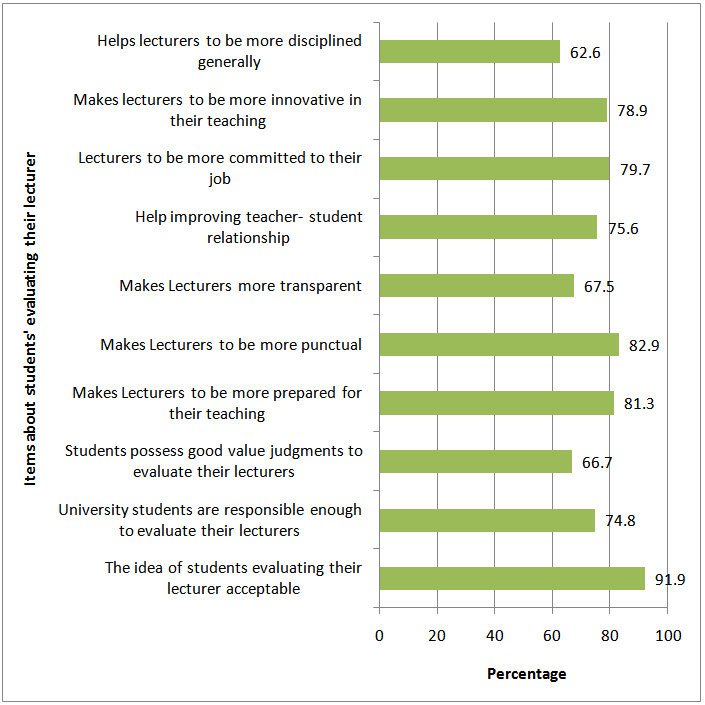 | Figure 1. Lecturers Perception on students competency in evaluating lecturers teaching effectiveness |
The pie chart in figure 2 gave the overall representation of lecturers perception on students competency to evaluate lecturers teaching effectiveness. This was categorized into three:- very positive 82.9%, positive 11.4%. and negative 9.7%. Majority had positive perception. 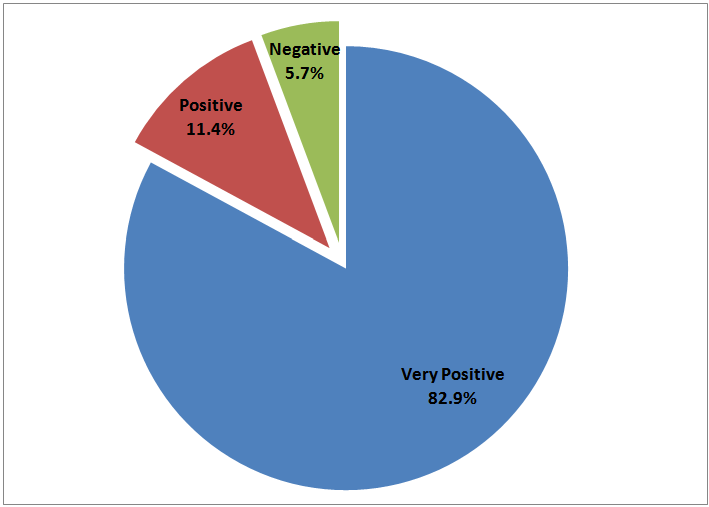 | Figure 2. Overall perception of Lecturers about Students’ competency in evaluating their lecturers’ teaching effectiveness |
Objective TwoDetermination of influence of Professional status, age, sex, and year of experience on lecturers perception of students competency in evaluating lecturers teaching effectiveness.The results as presented in Table 2 revealed that the Mean difference of male was 78.9 ± 12.9 and the female is 75.5 ± 14.0 with t =1.271, p > 0.05. This shows that there was no significant difference’ i.e. sex do not influence the perception of lectures on students competency in evaluating lecturers teaching effectiveness. Lecturers age were graduated into three levels (below 40, between the age range of 40 - 49 and above 50 years). The mean and standard deviation for each category was 77.5 ± 13.9, 79.5 ± 12.2, and 76.3 ± 14.0 respectively. The statistical result was F = 0.591, p > 0.05, i.e. there was no significant difference and that age had no influence in their perception. The effect of professional status was also verified on their perception and measured across all status. The perception of lecturers across status remained the same while year of work experience was also found not revealing any significant difference (F = 0.309. p > 0.05).Table 2. Influence of Professional status, age, sex and year of experience on lecturers’ perception about students’ competency in evaluating lecturers’ teaching effectiveness
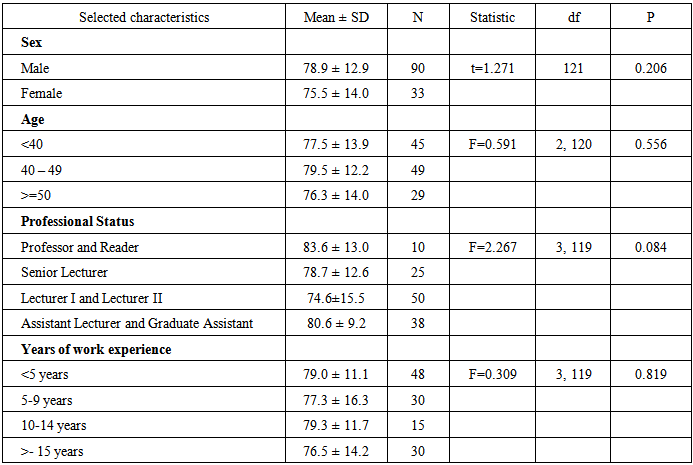 |
| |
|
Objective ThreeTo examine lecturers’ perception on the formative and summative functions of students evaluation report.Table 3. Lecturers perception on the formative and summative functions of students evaluation report
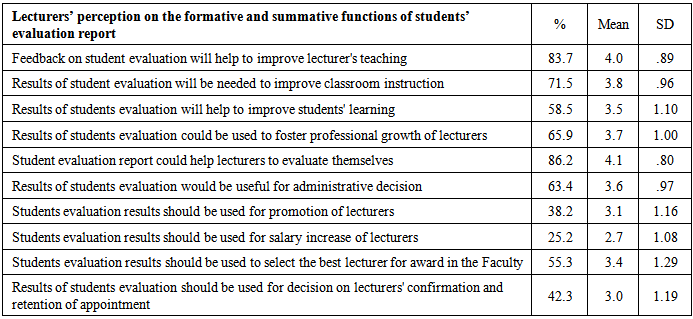 |
| |
|
There were ten items on the formative and summative functions of students evaluation results These items consisted of the fact that evaluation will help to improve lecturer teaching, (83%), improve classroom instruction (71.5%), foster professional growth of lecturers (65.9%), and that it could be useful for administrative decision (63.4%) Lecturers perception on the fact that the results of the evaluation should be used for promotion and salary increase was poor. (38.2. and 25.2% respectively). They were fairly indifference to the fact that the results could be used to select the best lecturer for award and also for confirmation of appointment (55.3 and 42.3%). Below in Figure 3 is the graphical illustration.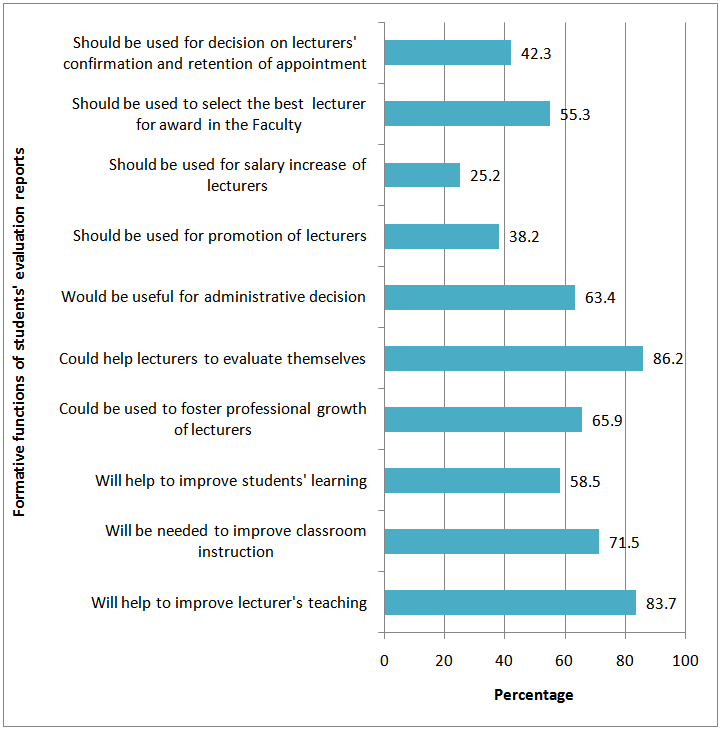 | Figure 3. Lecturers’ perception on the formative and summative functions of students’ evaluation report |
The results on the overall Perception of Lecturers about the formative and summative functions of students’ evaluation report revealed a very positive perception of 52%, moderately positive of 39.0% and negative perception 8.2%. This is illustrated by the chart in Figure 4.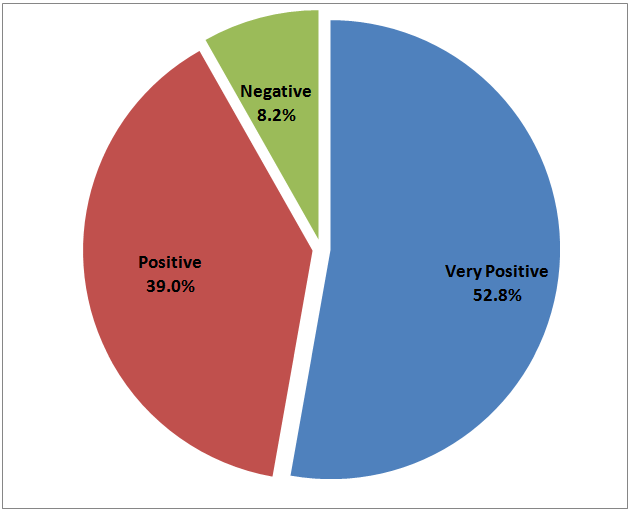 | Figure 4. Overall Perception of Lecturers about formative function of students’ evaluation report |
Research HypothesisSex, age, professional status and year of experience do not have any significant influence on the perception of lecturers on students evaluation of lecturers teaching effectiveness.Table 4. Influence of Sex, age, professional status and year of experience on the perception of lecturers on students evaluation of lecturers teaching effectiveness
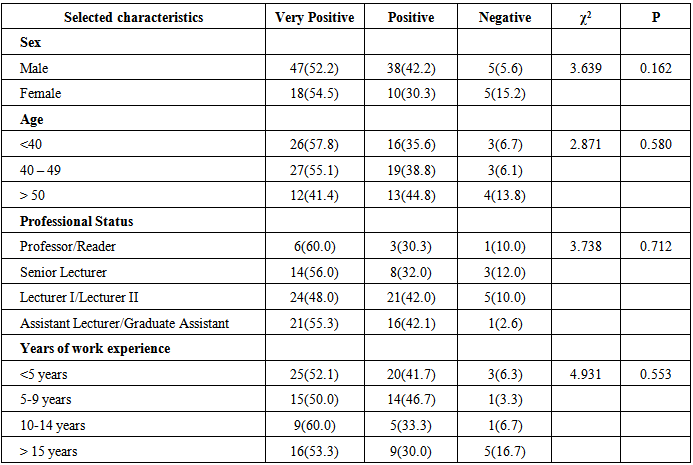 |
| |
|
The results revealed no significant difference in the perception of male and female lecturers (χ2 = 3.639. p > 0.05). Age do not significantly influence the perception of the lecturers (χ2 = 2.872 p > 0.05), professional status do not have any significant influence on the perception of lecturers (χ2 = 3.738, p > 0.05) and year of work experience had no significant influence on the perception of lecturers (χ2 = 4.931, p > 0.05).
4. Discussion
The overall perception of lecturers on students competency in evaluating lecturers teaching effectiveness revealed a very positive perception. This agree with the findings o [16] especially on the formative and summative evaluation. This result also established the findings of [3] who concluded that of all the techniques of evaluating lecturers effectiveness, students evaluation proved to be more effective as providing specific information for formative and summative purposes. Generally, lecturers even though their perceptions on the evaluation is positive they do not accept the fact that the evaluation results should be used for promotion and salary increase. This results confirmed the findings of [10].There was no significant difference in the perception of male and female lecturers. This negate the findings of [13] and [14] who found out that students perceived that female lecturers are biased and having an agenda rigid, grumpy and angry while the male were seen as objective. The fact that there was no significant difference in the perception of male and female lecturers revealed a uniformity of idea among lecturers. This therefore negate the opinion that some lectures felt that putting the power to evaluate lecturers into the hand of students will make the students to score down lecturers that insist on hard work. Year of work experience was also found not to yield a significant difference on the perception of the lectures. This also conformed with the findings of [2] and [10] both discovered that year of teaching experience do not make any significant difference in the lecturers perception.
5. Conclusions
From the results therefore, it could be concluded that lecturers evaluation is not an issue, students evaluation of lecturers teaching effectiveness is not also an issue but that the results of the evaluation if used for summative and formative should not be tied down to promotion of lecturers and payment of salaries.
ACKNOWLEDGEMENTS
The researcher wishes to acknowledge all lecturers who took part in the administration of the questionnaire, even in spite of their tight schedule. Also the secretary who did the type setting and others that were involved in the proof readings of the work are highly appreciated.
References
| [1] | H. S. Abdulkabir Strategies for Improving the Efficiency of Teachers in Jigawa State. Unpublished M.Ed Thesis University of Nsukka, (2006). |
| [2] | M. Jackson, Teacher characteristics and teaching effectiveness. Studies in Education, 12 (1), 101-112 (1998). |
| [3] | B. Johnson Should students evaluate their teachers? http;//edutopia.org.(2012) . Retrieved01/07/2013. |
| [4] | M. Gardener and B. Milton. Competent and the incompetent teacher. Journal of Education, 10: (1and2) 53-65. (2002) |
| [5] | N Norazuwa and N. Dahlan, A measurement of teaching effectiveness for public higher education institution in Malaysia. Proceedings of International conference of Teaching 2007. |
| [6] | Scriven, N., Students’ rating offer useful input to teachers’ evaluation. Practical assessment [1995]., research and evaluation. 4 (7). Retrieved 01/07/2013. |
| [7] | C.O. Otote. Assessment of the affective evaluation competences of social studies teacher in junior secondary schools in Edo (Unpublished PhD thesis, University of Benin, 2004). |
| [8] | B.A. Faleye & O. A Awopetu, A Revalidation of students evaluation of teaching effectiveness rating scale The African Symposium: An online journal of the African Educational Research Network. 18(12) 2012. |
| [9] | J. Franklin. Interpreting the numbers: Using a narrative to help others read student evaluations of your teaching accurately. In K.G. Lewis (Ed.), Techniques and strategies for interpreting student evaluations. New Directions for Teaching and Learning, 87, 85-100 (2001). |
| [10] | O.S. Ede, Iyamu Lecturers’ perception of student evaluation in Nigerian Universities. International Education Journal, 6(5), 619-625. (2005). |
| [11] | W, David, A Adebowale. Student evaluation of teaching effectiveness: A Nigerian investigation. Higher Education, 24(4): 453- 463 (1997). |
| [12] | R. Gold, Evaluation of instruction. Educational Studies, 15(1), 31-42. (2001). |
| [13] | C. H Farley Confronting Expectations: Women in the Legal Academy. Yale Journal of Law and Feminism. (1996). |
| [14] | M. A. Menny White Guy Habits in the Classroom. Men and Masculinities (2000). |
| [15] | M. Severino and W. Newman University Lecturers’ Perception of Students Evaluation of their Instructional Practices: Waiter Sisulu University, Center for Learning and Teaching Department, Republic of South Africa (2011). |
| [16] | H Idiaka, M T. Joshua, & W. A. Kristian, Attitudes of Academic Staff in Tertiary Educational Institution to Students Evaluation of Instructional (SEI) International Journal of Scholarly Academic Intellectual. (2006). |

 0.84. All items under the lecturers perception had a percentage above 50 which is an indication that lecturers had a positive perception towards students evaluation of their teaching effectiveness. This notwithstanding, the fact that majority supported the idea, there were reservations in some areas. The item that indicated that the evaluation will help lecturers to be .more disciplined had the lowest positive perception (62.6). This indicated that the lecturers had their reservations on the fact that affected whether they are disciplined or not or the way they choose to live their life. The results also revealed that the students were responsible enough to evaluate their lecturers (74.8%). There was the conscientious opinion that lecturers would be more prepared for their teaching if evaluated (81.3), and commitment to their job (79.7%). There was also a positive perception of the fact that the evaluation will make innovative in their teaching (78.9%).The bar chart in Figure 1 is a graphical representation of the information presented in Table 1.
0.84. All items under the lecturers perception had a percentage above 50 which is an indication that lecturers had a positive perception towards students evaluation of their teaching effectiveness. This notwithstanding, the fact that majority supported the idea, there were reservations in some areas. The item that indicated that the evaluation will help lecturers to be .more disciplined had the lowest positive perception (62.6). This indicated that the lecturers had their reservations on the fact that affected whether they are disciplined or not or the way they choose to live their life. The results also revealed that the students were responsible enough to evaluate their lecturers (74.8%). There was the conscientious opinion that lecturers would be more prepared for their teaching if evaluated (81.3), and commitment to their job (79.7%). There was also a positive perception of the fact that the evaluation will make innovative in their teaching (78.9%).The bar chart in Figure 1 is a graphical representation of the information presented in Table 1.



 Abstract
Abstract Reference
Reference Full-Text PDF
Full-Text PDF Full-text HTML
Full-text HTML



